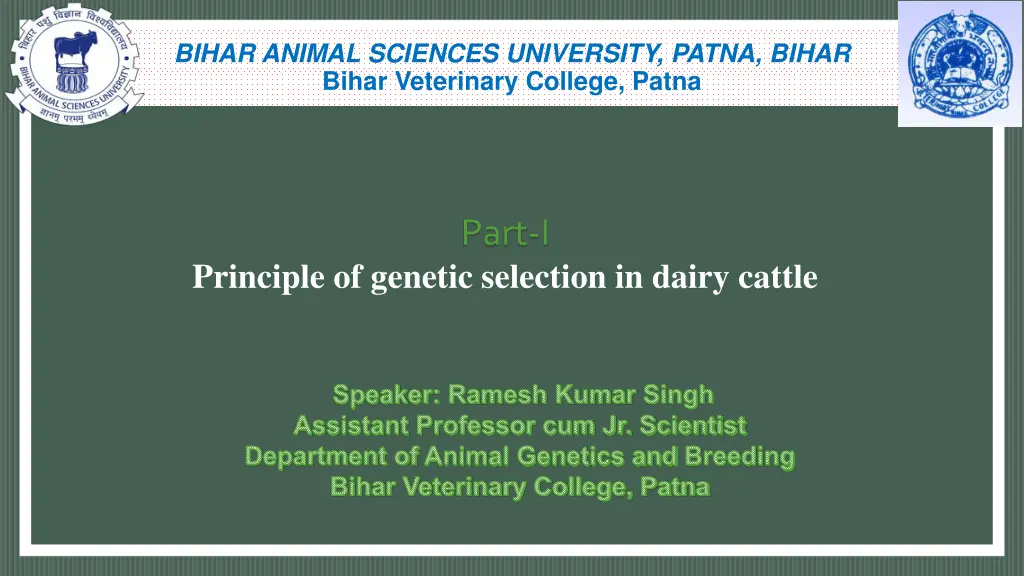
Principles of Genetic Selection in Dairy Cattle and Quantitative Genetics Overview
Explore the principles of genetic selection in dairy cattle and the fundamentals of quantitative genetics at Bihar Animal Sciences University, Patna. Learn how genetic improvement requires variation and how quantitative genetics studies traits controlled by multiple genes influenced by the environment, leading to continuous phenotype distribution in populations. Understand the basic principle that an individual's phenotypic value results from its genotype and environmental effects. Dive into the nuances of genotypic variation, additive and non-additive genetic effects, and the impact of environment on trait expression. Thank you for delving into this fascinating topic with Assistant Professor Ramesh Kumar Singh.
Uploaded on | 2 Views
Download Presentation

Please find below an Image/Link to download the presentation.
The content on the website is provided AS IS for your information and personal use only. It may not be sold, licensed, or shared on other websites without obtaining consent from the author. If you encounter any issues during the download, it is possible that the publisher has removed the file from their server.
You are allowed to download the files provided on this website for personal or commercial use, subject to the condition that they are used lawfully. All files are the property of their respective owners.
The content on the website is provided AS IS for your information and personal use only. It may not be sold, licensed, or shared on other websites without obtaining consent from the author.
E N D
Presentation Transcript
BIHAR ANIMAL SCIENCES UNIVERSITY, PATNA, BIHAR Bihar Veterinary College, Patna Part-I Principle of genetic selection in dairy cattle Speaker: Ramesh Kumar Singh Assistant Professor cum Jr. Scientist Department of Animal Genetics and Breeding Bihar Veterinary College, Patna
Principle of genetic selection in dairy cattle Principle of genetic selection in dairy cattle Genetic improvement requires variation. We can't select the best animals for a trait if every animal expresses the same phenotype.
Quantitative genetics Quantitative genetics one gene code for one trait (simple genetic determinism) However, traits for dairy production, such as yields, fertility and health are coded by many genes, are controlled by several genes, and their expression is influenced by the environment. Quantitative genetics is the study of the inheritance of traits that show a continuous distribution ofphenotypes in a segregating population. Traits that are controlled by many genes also exhibitquantitative inheritance as each gene segregates in a Mendelian way. Even when there are only a few genes involved, the trait variation will show a continuous distribution due to the results of measurement error and environmental effects. Quantitative genetics is considered to have been founded in the early 20th century, notably by R.A. Fisher article which showed that the inheritance of continuously varying traits is consistent with Mendelian principles.
The basic principle of quantitative genetics The basic principle of quantitative genetics Basically, the phenotypic value (P) of an individual is the combined result of its genotype (G) and the effects of the environment (E):
Genotype refers to the total genetic variation. This includes not only the effects of nuclear genes, but also the effects of mitochondrial genes and the interactions between genes. Genotypic variation can be partitioned into additive and non-additive variation. Additive variation represents the cumulative effect of individual loci, therefore the overall mean is equal to the summed contribution of these loci. Non-additive variation represents dominance variation (interaction between alleles) and epistasis variation (interaction between genes). Quantitatively varying traits are also affected by environment (E). This can be further subdivided into pure environmental effect and interaction between genes and the environment. In other words, how different genotypes respond in different environments.






















